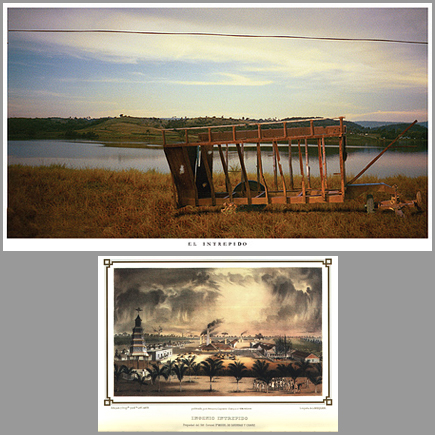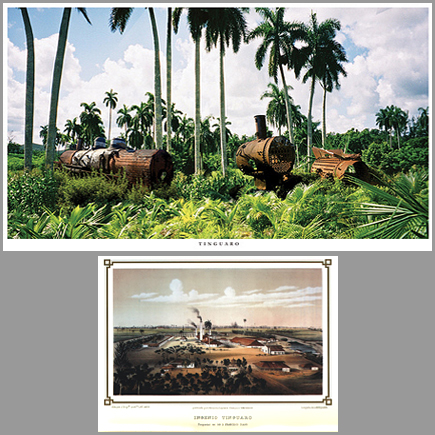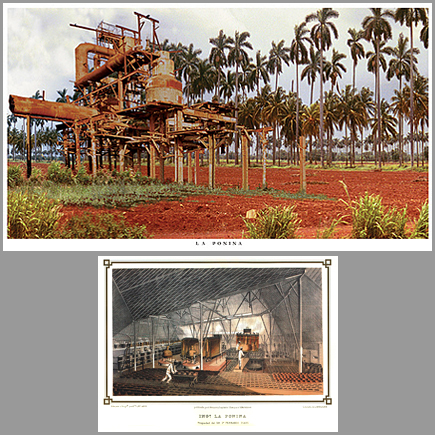Atelier Morales: Teresa Ayuso (Havana, Cuba, 1961) y Juan Luis Morales (Havana, Cuba, 1960) live and work in Paris, France. Bio's coming soon.
Los ingenios de la Isla de Cuba. From the series “Patrimonio a la deriva” Homage to Edouard Laplante (1818-1860) (sic.) Paris, France, December, 2004
Album Edition of 10 (Album #4)
Tempera on photography, 15 3/4 x 24 inches each
El Intrépido, Progreso, Tinguaro, La Ponina
Complimented by contemporary photo lithographs of the same places originally published: Edouard Laplante (Francia, active mid 19th Century), Illustrator and lithographer: Justo Germán Cantero (Trinidad, Cuba, 1815-1870), editor and writer: Los Ingenios. Colección de vistas de los principales ingenios de azúcar de la isla de Cuba, Imprenta de Louis Marquier, La Habana, 1857 Reproducciones, 15 3/4 x 24 inches each
Edouard Laplante- Atelier Morales- from Cubanet News. Prensa Independiente de Cuba.
Artist pair portrays ruins of Cuba's sugar industry
By Fabiola Santiago, Knight Ridder Newspapers, January 7, 2005.
MIAMI -- Browsing through a Paris flea market, Cuban architect and artist Juan Luis Morales found an old book that led him to the work of French painter and lithographer Eduardo Laplante, who moved to Cuba in 1849.
Laplante made 38 lithographs of the island's sugar mills. His colorful landscapes of smokestacks towering higher than royal palms and his romanticized view of life on the plantations inspired Morales and his wife/artistic partner, Teresa Ayuso, to return to Cuba and photograph the sugar mills as they are today.
The work of Atelier Morales, as the pair call their artistic alliance, is a tale of loss and an ode to poetic memory.
In their series "Los Ingenios: Patrimonio a la deriva" ("Adrift Patrimony: Sugar Refineries," 2004), the couple captures with a bitterly beautiful technique of digital photography and gouache the ruined remnants of what once was a thriving industry.
Steel carcasses of defunct sugar mills rise amid vividly green but sadly empty landscapes. An overturned wooden boat sits at what was once the royal-palm-lined entrance of a grand plantation. A rusted locomotive peers from the overgrown brush overtaking a no-longer-bustling sugar cane train route.
"An entire industry destroyed, a way of life lost and no one thought to at least preserve some of these historical relics and turn them into museums for the generations," says Morales, who has been living in Paris since 1996 and was in Miami to exhibit his work at Art Basel Miami Beach.
The prints are painted with traces of gouache, highlighting and romanticizing the natural beauty surrounding the ruins. In some, Morales kept as titles the poetic names of the sugar mills -- Flor de Cuba, Buena Vista, Narciso, Tinguaro, Constancia. He titled one piece "Cimarrones" because the pieces of steel are "like slaves running away" through the thick landscape. "Acana" shows the regal entrance of a plantation and "Vereda" the exit route for the train.
"We wanted to rescue the romantic charge that Laplante brought to his lithographs in the 19th century with illumination, composition and color," Morales says. "You don't see the cruel world of slavery in the plantations, and we wanted to recuperate that beautiful part. It's not a negation of the bad part of history. We wanted to show that history, good and bad, being erased, disappearing."
Morales hopes people will want to collect his sugar mill prints, as Cubans did a century ago with Laplante's popular lithographs.
Commissioned by magnate Justo Cantero, Laplante's lithographs are considered a relic, as is Cantero's book, in which the drawings were first published in 1857, "Vistas de los principales ingenios de Cuba" ("Views From The Most Important Sugar Refineries in Cuba").
Followed Laplante's trail
In his trips to the island, Morales followed Laplante's trail through southern Havana, Matanzas and Las Villas, sometimes riding on the same train routes that used to take the sugar to the ports of Havana and Cardenas, to be shipped to the United States and Europe.
In his research, Morales discovered that the original Laplante drawings, and two of the original editions of Cantero's book "mysteriously disappeared" from Palacio de Junco in the Museum of Matanzas in 1993.
"That is part of the lost patrimony, all the valuable treasures that are disappearing from Cuba, stolen and sold," Morales says. "Works of art, books, and archival documents have disappeared from all of the national Cuban museums; that's why I call my work Patrimony Adrift."
Loss has been the running theme of Atelier Morales' work since Morales, 44, and Ayuso, 43, formed it in 1993.
The graduates of the University of Havana's School of Architecture have exhibited in Paris, Spain and New York and are represented by Mexico City-based Menocal, one of the leading dealers of top emerging Cuban artists on the island and in exile.
Images of loss
Last year's series, "Bohios," a mix of photography, painting and collage, also shown at Art Basel Miami Beach, portrayed eerie images of bohios, the typical homes in the Cuban countryside, some run-down and stacked up over each other, others at the seashore, as if they too, were leaving the island
Also touching is their three-part series "No es mas que la vida" ("It's Only Life," 2004), in which Atelier Morales tackles water, smoke and wind as metaphoric elements of loss
The water series, "Agua," shows a china cabinet as if it were slowly drowning. On the top shelf, one can clearly see a set of dainty antique demitasse cups. But with each shelf, items get murkier, more difficult to recognize, until water completely clouds over the cabinet. |
 El Intrépido, 2004
El Intrépido, 2004  Progreso, 2004
Progreso, 2004  Tinguaro, 2004
Tinguaro, 2004  La Ponina, 2004
La Ponina, 2004 
